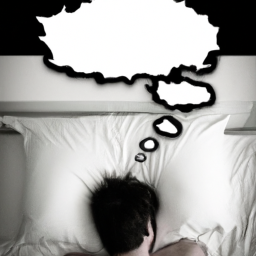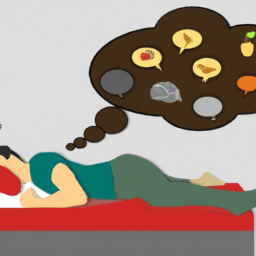I have always been fascinated by dreams and their meanings, which has prompted me to delve into Carl Jung’s ideas about what dreams are trying to tell us.
As a renowned Swiss psychiatrist and psychoanalyst, Jung developed theories about the unconscious mind and the role it plays in our dreams.
According to Jung, our dreams are not random, but rather a reflection of our innermost thoughts and emotions. Jung believed that dreams originate from the unconscious mind, which he described as the part of our psyche that is not immediately accessible to our conscious awareness.
He believed that the unconscious mind contains our deepest fears, desires, and memories, and that our dreams are a way for these thoughts and emotions to surface and be expressed. For Jung, dreams were not just a way to process our daily experiences, but also a tool for personal growth and self-discovery.
Key Takeaways
- Dreams originate from the unconscious mind, which contains our deepest fears, desires, and memories.
- Dreams are a reflection of our innermost thoughts and emotions, and serve as a tool for personal growth and self-discovery.
- The unconscious mind includes both personal and collective elements, making it a rich source of imagery and symbolism in dreams.
- Dream interpretation is crucial in gaining a deeper understanding of ourselves and our experiences, and can reveal our deepest desires, fears, and motivations.
The Unconscious Mind
When it comes to the unconscious mind, one of the most fascinating aspects is its role in dream formation.
Carl Jung believed that dreams came from the unconscious, which he described as the part of the mind that holds our deepest, most primal thoughts and instincts.
This definition of the unconscious includes both personal and collective elements, making it a rich source of imagery and symbolism in dreams.
Definition and Characteristics
You’ll notice that dreams have distinct characteristics that set them apart from waking life. Dreams are often bizarre, illogical, and unpredictable. They are filled with symbolism and imagery that may seem unrelated to our daily experiences. Dreams can also evoke strong emotions, ranging from fear and anxiety to joy and happiness.
These characteristics of dreams are believed to be the result of the unconscious mind. According to Carl Jung, the unconscious mind is a repository of all the thoughts, memories, and emotions that aren’t currently in our conscious awareness. Dreams are a way for the unconscious mind to communicate with the conscious mind, allowing us to process and make sense of our experiences.
In the next section, I’ll explore the role that the unconscious mind plays in dream formation.
Role in Dream Formation
The role of the unconscious mind in dream formation is crucial, as it’s responsible for processing and organizing all the thoughts and emotions we’re not aware of while awake.
Dreams are a way for our unconscious mind to communicate with us and provide insight into our deepest desires, fears, and conflicts. They can reveal things about ourselves we may not be aware of consciously, and help us process difficult experiences and emotions.
Research has shown that people who are more open to new experiences tend to have more vivid and creative dreams. This suggests that our level of openness to new experiences may influence the types of information our unconscious mind presents to us through our dreams.
With this in mind, let’s explore Carl Jung’s theory on the origin of dreams and how it relates to the role of the unconscious mind in dream formation.
Jung’s Theory on the Origin of Dreams
Jung believed that dreams originate from the unconscious mind, where repressed thoughts and emotions reside. He believed that the unconscious mind is a vast and complex realm that is still largely unexplored.
Dreams are, according to Jung, a window into this mysterious realm, allowing us to glimpse what lies beneath the surface of our conscious minds. Jung’s theory on the origin of dreams is based on the idea that our unconscious mind is constantly at work, processing and integrating our experiences and emotions.
Dreams are the product of this process, and they offer us a unique opportunity to access the deeper parts of ourselves. Understanding the origin of dreams is important because it helps us to better understand ourselves and our experiences. This is where the importance of dream interpretation comes in.
The Importance of Dream Interpretation
Why is interpreting our dreams so crucial, and how can it benefit our understanding of ourselves? Dream interpretation has always been a significant aspect of psychology, and it is believed that our dreams carry symbolic meanings that can help us gain insights into our unconscious mind. Dreams can reveal our deepest desires, fears, and motivations that we may not be aware of consciously. Understanding these unconscious thoughts can help us deal with our emotions better and make more informed decisions in our waking life.
To emphasize the significance of dream interpretation, I have created a table that showcases some of the common dream symbols and their potential meanings. As we can see from the table, our dreams can be interpreted in various ways, and the symbolism can differ from person to person based on their personal experiences and cultural background. However, the key takeaway is that our dreams are not random, and they carry a hidden message that we can decode to gain a better understanding of ourselves. By interpreting our dreams, we can unlock our innermost thoughts and emotions and use them to improve our emotional well-being and lead a more fulfilling life.
Moving on to the next section about common dream symbols and their meanings, we can delve deeper into the world of dream interpretation and explore how different symbols can be interpreted in various ways.
Common Dream Symbols and Their Meanings
Now, let’s explore some common symbols in your dreams and what they might mean for you. Dreams are often filled with symbols that can be difficult to interpret, but understanding the meaning behind these symbols can provide insight into your subconscious mind and help you better understand your emotions, thoughts, and behaviors.
Here are three common dream symbols and their possible meanings:
-
Falling: This is a common dream symbol that can indicate a feeling of loss or failure in your waking life. You may feel like you’re losing control or that things are slipping away from you. Alternatively, falling can also represent a new beginning or a change in direction.
-
Teeth: Dreaming about teeth can be a sign of anxiety or stress. It can also represent a fear of aging or losing your youth. On the other hand, teeth can also symbolize power and strength.
-
Water: Water is a powerful symbol in dreams and can represent a range of emotions and experiences. Calm, clear water can signify peace and tranquility, while rough, choppy water can represent turmoil and uncertainty. Water can also symbolize creativity and the flow of ideas.
Understanding these symbols can be the first step in unlocking the meaning behind your dreams. In the next section, we’ll explore some techniques for analyzing your dreams in more detail.
Techniques for Analyzing Dreams
When it comes to analyzing dreams, I find that keeping a dream journal is a helpful technique. Writing down the details of my dreams as soon as I wake up helps me remember them more vividly and identify recurring themes.
I also like to explore my personal associations with the symbols and images in my dreams, and sometimes I consult with a psychologist to gain a deeper understanding of their meanings.
Keeping a Dream Journal
By jotting down your dreams in a journal, you can unlock the hidden messages and symbols that your subconscious mind is trying to communicate to you. Keeping a dream journal is a powerful tool that can help you understand yourself better and gain insights into your life.
Here are some tips to help you get started:
- Keep your journal close to your bed: This way, you can jot down your dreams as soon as you wake up, before they fade away.
- Write down everything you remember: Even if it seems bizarre or insignificant, write it down. You never know what might be important.
- Draw or sketch your dreams: This can help you capture the visual aspects of your dreams, which can be particularly helpful in interpreting them.
- Look for patterns: Pay attention to recurring themes or symbols in your dreams. They may be trying to tell you something.
- Reflect on your emotions: How did your dream make you feel? What emotions did it evoke? This can provide clues to the meaning of your dream.
By exploring personal associations, you can delve deeper into the meaning and significance of your dreams.
Exploring Personal Associations
Delving into personal associations can be a fun and rewarding way to gain a deeper understanding of the messages hidden within your dreams. When I explore my personal associations, I try to think about the people, objects, or situations that come up in my dreams and what they might represent to me.
For example, if I dream about a snake, I might think about what snakes mean to me personally. Do they scare me? Do they remind me of a specific person or memory?
This process can be challenging at times, as it requires honesty and self-reflection. However, it can also provide valuable insights into my subconscious thoughts and emotions. By understanding my personal associations, I can begin to unravel the symbolic language of my dreams and uncover their deeper meanings.
This can then lead me to the next step of consulting with a psychologist for further interpretation and guidance.
Consulting with a Psychologist
If you’re looking to uncover the deeper meanings of your dreams, consider consulting with a psychologist. A trained psychologist can help you explore your dreams in a safe and supportive environment. They can also provide insight into the underlying psychological factors that may be influencing your dream content.
During a dream analysis session with a psychologist, you may be asked to recall specific details of your dream, such as people, places, and emotions. This information can then be used to identify common themes and patterns in your dreams. By exploring these themes, you can gain a deeper understanding of your unconscious mind and the messages it may be trying to communicate to you.
Jung’s influence on modern dream interpretation can be seen in the emphasis on symbolism and archetypes in dream analysis. By understanding the symbolic meanings behind certain dream images, individuals can gain insight into their own psyche and the collective unconscious. This approach to dream analysis has helped many individuals gain a deeper understanding of themselves and the world around them.
Jung’s Influence on Modern Dream Interpretation
Hey, did you know that modern dream interpretation owes a lot to Carl Jung’s theories on the unconscious mind?
Jung believed that dreams were a reflection of the unconscious mind, which contained all of our repressed thoughts, desires, and emotions. He saw dreams as a way for the unconscious mind to communicate with the conscious mind, and believed that by analyzing our dreams, we could gain insight into our deepest fears, hopes, and motivations.
Jung’s theories on dream interpretation have had a lasting impact on modern psychology, and are still widely used today. However, his ideas have also faced criticism from some psychologists, who argue that his focus on the symbolic meaning of dreams can lead to subjective interpretations that are not based in scientific evidence.
Despite these criticisms, Jung’s ideas on the unconscious mind and dream interpretation continue to influence the way we think about and understand our own minds.
Criticisms of Jung’s Theory
You might be surprised to learn that some psychologists criticize Carl Jung’s theories on dream interpretation. One of the main criticisms is that Jung’s approach relies heavily on symbolism and archetypes, which can be highly subjective and difficult to interpret accurately. Critics argue that this approach is too abstract and lacks empirical evidence to support its claims.
Additionally, some psychologists argue that Jung’s theory is too focused on the individual and fails to take into account the social and cultural influences on dreams. Dreams are shaped by our experiences and interactions with others, and Jung’s theory overlooks this important aspect of dream interpretation.
Despite these criticisms, many psychologists still find value in Jung’s approach and continue to apply his theories in their practice. However, it is important to consider the limitations and potential biases of any theory, including Jung’s.
In the next section, we will explore how Jung’s ideas have been applied in other areas of psychology.
Application of Jung’s Theory in Other Areas of Psychology
Now that you understand the criticisms of Jung’s theory, let’s explore how other psychologists have applied his ideas in various fields of psychology.
Jung’s concepts have been used in many areas of psychology, including counseling, education, and personality research. Here are some examples:
-
Counseling: Jung’s idea of the collective unconscious has been used in counseling to help clients understand their own behaviors and attitudes. Counselors may use dream analysis to identify unconscious patterns and help clients develop new ways of thinking and behaving.
-
Education: Jung’s theory of personality has been applied to education to help teachers understand different learning styles and how to cater to them. For example, some students may be more introverted and prefer to work independently, while others may be more extroverted and thrive in group settings.
-
Personality research: Jung’s concept of archetypes has been used in personality research to identify common patterns of behavior and thought. Researchers may use personality tests to identify archetypes in individuals and study how they relate to different aspects of personality.
-
Creative arts: Jung’s ideas about the role of the unconscious in creativity have been used in the creative arts, such as literature, music, and visual art. Artists may use dream analysis and other techniques to tap into their unconscious and create works that are more meaningful and authentic.
Frequently Asked Questions
What is Carl Jung’s background and education?
I am Carl Jung. I was a Swiss psychiatrist and psychoanalyst who founded analytical psychology. I studied medicine and psychology, and my interest in mythology and religion heavily influenced my theories.
What other theories on dreams were prevalent during Jung’s time?
During Jung’s time, Freud’s theory of dreams as wish fulfillment was popular. However, I believe dreams are the unconscious mind’s way of communicating with us, revealing repressed emotions and unresolved conflicts.
How has Jung’s theory on dreams been received by the scientific community?
I believe Jung’s theory on dreams has been met with mixed reception among the scientific community. While some embrace his ideas, others remain skeptical due to a lack of empirical evidence to support his claims.
What are some common misconceptions about Jung’s theory on dreams?
Some common misconceptions about Jung’s theory on dreams include the idea that he believed all dreams were symbolic and that he thought they provided direct solutions to problems. However, his views were more nuanced than that.
How has Jung’s theory on dreams influenced other areas of psychology besides dream interpretation?
Jung’s theory on dreams has influenced various areas of psychology beyond dream interpretation. For instance, his concept of the collective unconscious has been applied to the study of cultural symbols and archetypes.
Conclusion
So there you have it, folks. Carl Jung believed that dreams came from the unconscious mind, a reservoir of thoughts and feelings that are hidden from our conscious awareness.
He believed that dreams were a way for the unconscious to communicate with the conscious mind, providing insights and guidance that could help us navigate the challenges of life.
Despite criticisms of his theory, Jung’s influence on modern dream interpretation cannot be denied. His emphasis on the importance of understanding the symbolic language of dreams has helped countless people gain a deeper understanding of themselves and their place in the world.
Whether you’re a psychologist, therapist, or simply someone who’s interested in exploring the mysteries of the mind, Jung’s insights into the origin of dreams are a valuable resource that can help you unlock the secrets of your own unconscious.









